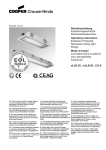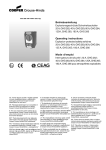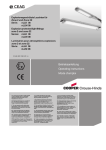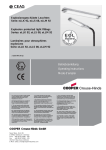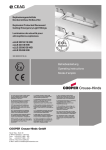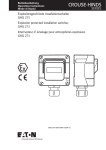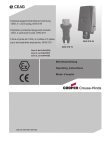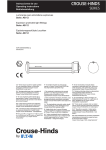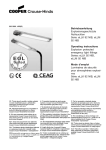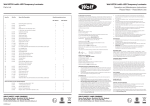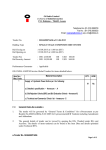Download Betriebsanleitung Explosionsgeschützte Deckeneinbauleuchten
Transcript
Betriebsanleitung Explosionsgeschützte Deckeneinbauleuchten Operating instructions Explosion Protected Recessed Ceiling light fittings RLF 25... CZ: "Tento návod k použití si mĤžete vyžádat ve svém mateĜském jazyce u pĜíslušného zastoupení spoleþnosti Cooper CrouseHinds/CEAG ve vaší zemi." DK: "Montagevejledningen kan oversættes til andre EU-sprog og rekvireres hos Deres Cooper Crouse-Hinds/CEAG leverandør" H: "A kezelési útmutatót az adott ország nyelvén a Cooper Crouse-Hinds/CEAG cég helyi képviseletén igényelheti meg." I: "Se desiderate la traduzione del manuale operativo in un´altra lingua della Comunit à Europea potete richiederla al vostro rappresentante Cooper Crouse-Hinds/CEAG" P: "Se for necessária a tradução destas instruções de operação para outro idioma da União Europeia, pode solicita-la junto do seu representante Cooper Crouse-Hinds/CEAG" PL: Niniejszą instrukcjĊ obsáugi w odpowiedniej wersji jĊzykowej moĪna zamówiü w przedstawicielstwie firmy Cooper-CrouseHinds/CEAG na dany kraj. LT: Šios naudojimo instrukcijos, išverstos Ƴ Jnjsǐ S: "En översättning av denna montage- och gimtąją kalbą, galite pareikalauti atsakingoje "Cooper Crouse-Hinds/CEAG" atstovybơje savo skötselinstruktion till annat EU - språk kan vid behov beställas från Er Cooper Crousešalyje. Hinds/CEAG- representant" LV: "Šo ekspluatƗcijas instrukciju valsts valodƗ EST: "Seda kasutusjuhendit oma riigikeeles SK: "Tento návod na obsluhu Vám vo Vašom varat pieprasƯt jnjsu valsts atbildƯgajƗ Cooper võite küsida oma riigis asuvast asjaomasest rodnom jazyku poskytne zastúpenie spoloþnosti Crouse-Hinds/CEAG pƗrstƗvniecƯbƗ." Cooper Crouse-Hindsi/CEAG esindusest." Cooper Crouse-Hinds/CEAG vo Vašej krajine." FIN: "Tarvittaessa tämän käyttöohjeen käännös M: Jistgƫu jitolbu dan il-manwal fil-lingwa nazzjonali tagƫhom mingƫand ir-rappreĪentant SLO: "Navodila za uporabo v Vašem jeziku on saatavissa toisella EU:n kielellä Teidän lahko zahtevate pri pristojnem zastopništvu Cooper Crouse-Hinds/CEAG - edustajaltanne" ta' Cooper Crouse Hinds/CEAG f'pajjiĪhom. podjetja Cooper Crouse-Hinds/CEAG v Vaši doW(DQFUHLDVTHLPHWDMUDVKWZQRGKJLZQFUKVH NL: "Indien noodzakelijk kan de vertaling van državi." Z9VHDOOKJOZVVDWK9((PSRUHLQD]KWKTHLDSR deze gebruiksinstructie in een andere EU-taal worden opgevraagd bij Uw Cooper CrouseWRQ$QWLSURVZSRWK9Cooper CrouseHinds/CEAG - vertegenwoordiging" Hinds/CEAG? E: "En caso necesario podrá solicitar de su representante Cooper Crouse-Hinds/CEAG estas instrucciones de servicio en otro idioma de la Union Europea" 300 8000 2077 D/E (a) Schaltplan Serie RLF 25..(18W, 36W, 58 W) Wiring diagram series RLF 25..(18W, 36W, 58 W) Schéma des connexions, série RLF 25..(18W, 36W, 58 W) RLF 25018/18 RLF 25036/36 RLF 25058/58 Nur bei Only Seulement pour luminaire à RLF 250336 RLF 250358 Nur bei Only Seulement pour luminaire à RLF 250418 RLF 250436 RLF 250458 RLF 25... Ausführung/ Version/Modèle Spannungsbereich AC ± 10%/ voltage range AC ± 10% Gamme des tensions CA ± 10% Frequenzbereich/Frequency range Gamme des fréquences Spannungsbereich DC / Voltage range DC Gamme des tensions CC kurzzeitige Überspannung AC/DC Transient excess voltage AC/DC Surtension transitoire CA/CC Nennstrom in/A Rated current/A Courant nom. en A avec: 230 V AC 220 V DC 2 x 18 W (4 x 18 W) 110 - 254 V 2 x 36 W (4 x 36 W) 110 - 254 V 2 x 58 W ( 4 x 58 W) 220 - 254 V 3 x 36 W 3 x 58 W 110 - 254 V 220 - 254 V 50 - 60 Hz 50 - 60 Hz 50 - 60 Hz 50 - 60 Hz 50 - 60 Hz 195 - 250 V 110 - 127 V 1) 110 - 250 V 195 - 250 V 110 - 250 V 195 - 250 V 0,53 (1,06) 0,54 (1,07) 0,52 0,53 0,80 0,81 <350 V 0,18 (0,36) 0,19 (0,37) 0,34 (0,68) 0,35 (0,69) 1) optional 2) zulässige Toleranzen gemäß EN 50014/max. permissable tolerances accd. EN 50014/Tolerances admissible selon EN 50014: ± 10 % 2 Cooper Crouse-Hinds GmbH Montagebilder/Maßzeichnung Illustrations for mounting/Dimensional drawing 1 2 3 4 3b 3a 5 8 12 1-4 9 6 7 10 11 13 Cooper Crouse-Hinds GmbH 3 1. Sicherheitshinweise: Zielgruppe: Elekrofachkräfte und unterwiesene Personen. U Die Leuchte darf nicht in den Zonen 0 und 20 eingesetzt werden! Die Anforderungen der EN 61241-0 und -1 u.a. in Bezug auf übermäßige Staubablagerungen und Temperatur, sind vom Anwender zu beachten. U Die auf der Leuchte angegebenen technischen Daten sind zu beachten! U Umbauten oder Veränderungen an der Leuchte sind nicht zulässig! U Die Leuchte ist bestimmungsgemäß in unbeschädigtem und einwandfreiem Zustand zu betreiben! U Als Ersatz dürfen nur Originalteile von Cooper Crouse-Hinds (CCH)CEAG verwendet werden! U Reparaturen, die den Explosionsschutz betreffen, dürfen nur von CCH/CEAG oder einer qualifizierten „Elektrofachkraft“ durchgeführt werden! U Lassen Sie diese Betriebsanleitung während des Betriebes nicht in der Leuchte! U Beachten Sie die nationalen Unfallverhütungsund Sicherheitsvorschriften und die nachfolgenden Sicherheitshinweise, die in dieser Betriebsanleitung ) gekennzeichnet sind! mit einem ( 2. Normenkonformität Diese Leuchte ist zum Einsatz in explosionsgefährdeten Bereichen der Zone 1,2, 21 und 22 gemäß EN 60079-10 und IEC 61241-10 geeignet. Das eingebaute EVG 05 erfüllt die Anforderungen der EN/IEC 60079-7 -4 Ausgabe (EOL) und den Anforderungen der IEC 61347-2-3 (§17.2 und §17.3). Sie wurde entsprechend dem Stand der Technik und gemäß DIN EN ISO 9001:2000 entwickelt, gefertigt und geprüft. 3. Technische Daten EG-Baumusterprüfbescheinigung: FTZÚ 06 ATEX 0050X Kennzeichnung nach94/9/EG II 2 G Ex de IIC T4 II 2 D Ex tD A21 IP65 T60 °C Schutzklasse nach EN 61140: I Schutzart nach EN 60529 IP65 zulässige Umgebungstemperatur -20 °C bis +40 °C Lagertemperatur in der Originalverpackung: -25 °C bis +60 °C Lampenbestückung: Zweistiftlampenfassung G13 nach 18 W IEC 60081-22/20 36 W IEC 60081-24/20 58 W IEC 60081-21/22 Klemmvermögen Anschlussklemme 2x je Klemme: 4 mm² Leiterquerschnitt bei Durchgangsverdrahtung: 2,5 mm2 für max. 16 A Ex e-Kabel- und Leitungseinführung Standardausführung: M25x1,5 für Leitungen Ø 8 bis 17 mm Metall: M20x1,5 Innengewinde Prüfdrehmoment für Ex-e Kabel- und Leitungseinführung M25x1,5: 5,0 Nm Prüfdrehmoment für Druckschraube: 3,5 Nm (für Abdichtung Leitung oder Verschlussstopfen) Prüfdrehmoment für ScheibenSchlitzschraube: 1,5 Nm Gewicht 18/36/58 W (2-lampig): ca. 6,9/ 12,9/ 17,2 kg 18/36/58 W (3-lampig): ca. 7,5/ 13,4/ 17,8 kg 18/36/58 W (4-lampig): ca. 9,5/16,5 /19,8 kg 4 Cooper Crouse-Hinds GmbH 4. Installation Einsetzen der Lampe: Verwenden Sie nur solche Lampen, die für diese Leuchten zugelassen sind, siehe Technische Daten und Typenschild! T12-Lampen (Ø 38 mm) werden von der EOLSchaltung als fehlerhaft erkannt und abgeschaltet! Achtung: Sicherheitstechnische Hinweise des Lampenherstellers beachten Öffnen und Schließen der Leuchte U Die Schlitzschrauben mit geeignetem Schraubendreher lösen und Schutzscheibe abklappen, siehe Bild 1 und 2. U Achtung! Die Schutzscheibe ist nicht gegen Herabfallen gesichert! U Zum Schließen der Schutzscheibe Schrauben nur handfest anziehen.(Prüfdrehmoment: 1,5 Nm) Zweistiftsockellampe (G13) Führen sie die Lampen in die Fassung ein. Drücken sie dabei den Betätigungsknopf an der Fassung (Bild 3a). Die Lampe muss fest in der Lampenfassung sein. Prüfen sie den festen Sitz durch leichtes Ziehen an der Lampe (Bild 3b). Montageabmessungen: siehe Bild 13 5. Inbetriebnahme Halten Sie die für das Errichten und Betreiben von explosionsgeschützten elektrischen Betriebsmitteln geltenden Sicherheitsvorschriften gemäß des Gerätesicherheitsgesetzes sowie die allgemein anerkannten Regeln der Technik ein! Transport und Lagerung der Leuchte ist nur in Originalverpackung und angegebener Lage gestattet! Deckeneinbau (Bild 12 und 13) Beachten Sie die Maße für den Deckenausschnitt! 1. Gewindebohrungen an der Rückseite M8 x 18 mm tief zur Deckenmontage. 2. Deckeneinbau in ausreichend tragfähige Deckenkonstruktionen: seitliche Befestigungslöcher im Rahmen mit geeigneten Schrauben befestigen (Option) 3. Montagebügel zur stirnseitigen Befestigung (Option) siehe Bild 12 Verwenden Sie keine zu langen Schrauben! Montagezubehör: s. Cooper Crouse-Hinds-Katalog. Netzanschluss U Hängen sie die Schutzscheibe aus den Scharnieren aus. U Lösen sie die 4 Befestigungsschrauben am Reflektor um ca. 3 Umdrehungen (Bild 5, 6) U Schieben sie den Reflektor nach rechts aus der Schraube heraus und entnehmen sie den Reflektor (Bild 7). U Lösen sie die Schutzleiterverbindung am Klemmstein oder am Gehäuse (Bild 8). Achten sie auf die Position der Zahnscheibe (Schraubenkopf, Kabelschuh, Zahnscheibe U Führen Sie die Leitung durch die Ex-Kabel- und Leitungseinführung ein. Bei Benutzung der CCH/CEAG Leitungseinführung M25 (PA) verwenden Sie für Leitungen von 8 bis 12 mm beide Dichtungseinsätze, von 12 bis 17 mm nur den äußeren Dichtungseinsatz. Achten Sie auf korrekten Sitz des verbleibenden Dichtungseinsatzes in der Verschraubung. U Klemmen Sie die Leitungen an den Anschlussklemmen PE, N, L(Bild 10) gemäß Klemmenbezeichnung an (Bild 11). U Schließen sie die Schutzleiterverbindung am Gehäuse an (Bild 8,9). U Führen sie den Reflektor in die 4 Befestigungsschrauben ein (Bild 7) U Beim Schließen des Reflektors ist darauf zu achten, dass keine Leitungen eingequetscht werden. U Ziehen sie alle 4 Schrauben fest an. U Erst danach die Leitungseinführung fest anziehen U Hängen sie die Schutzscheibe in die Scharnierhaken ein. U Führen sie die Lampen in die Fassung ein. Drücken sie dabei den Betätigungsknopf an der Fassung (Bild 3a). Die Lampe muss fest in der Lampenfassung sein. Prüfen sie den festen Sitz durch leichtes Ziehen an der Lampe (Bild 3b) U Verschließen sie die Schutzscheibe mit den Verschlussschrauben (Bild 1) Achtung: Bei nicht benutzten Kabel-und Leitungseinführungen ist die Schutzscheibe zu entfernen und durch einen Verschlussstopfen (Drehmoment 3,5 Nm) zu verschließen. Beim Verschließen mit einem Verschlussstopfen stets beide Dichtungseinsätze verwenden! Bei Metall-Kabeleinführungen sind die Schutzkappen der nicht benutzten Einführungen zu entfernen und durch bescheinigte Ex-Verschlussstopfen (min. IP 66) zu verschließen! U Überprüfen Sie vor der Inbetriebnahme die korrekte Funktion und Installation der Leuchte in Übereinstimmung mit dieser Betriebsanleitung und anderen zutreffenden Bestimmungen! U Führen Sie Isolationsmessungen nur zwischen PE und Außenleiter L1 (L2,L3) sowie zwischen PE und N durch! - Messspannung: max. 1kV AC/DC - Messstrom: max. 10 mA 6. Instandhaltung Halten Sie die für die Instandhaltung, Wartung und Prüfung von explosionsgeschützten Betriebsmitteln geltenden Bestimmungen z.B. IEC 60079-17 ein! Wartung: Im Rahmen der Wartung sind vor allem die Teile, von denen die Zündschutzart abhängt, zu prüfen z.B.: U Gehäuse und Schutzglas auf Risse und Beschädigungen. U Dichtungen auf Beschädigungen. U Klemmen und Verschlussstopfen auf festen Sitz. Lampenwechsel: U Beachten Sie für den Lampenwechsel die Wechselintervalle gemäß Vorgabe der Lampenhersteller! U Ein Lampenwechsel kann ohne Freischalten vom Netz durchgeführt werden, da die Fassungen beim Öffnen der Schutzwanne durch einen allpoligen Trennschalter spannungsfrei geschaltet werden. Beachten sie jedoch, dass nationale Vorschriften oder lokale Anwendungsrichtlinien hiervon abweichend sein können! Instandsetzung Vor dem Austausch oder der Demontage von Einzelteilen ist folgendes zu beachten: Schalten Sie das Betriebsmittel vor dem Öffnen oder vor Instandhaltungsarbeiten erst spannungsfrei! Benutzen Sie nur von CCH/CEAG freigegebene Ersatzteile! Siehe Ersatzteilkatalog CCH/CEAG. Programmänderungen und -ergänzungen sind vobehalten. Bei der Entsorgung nationale Abfallbeseitigungsvorschriften beachten! Die Kunststoffmaterialien sind mit Materialkennzeichnungen versehen. 1. Safety instructions For skilled electricians and instructed personnel in accordance with national legislation, including the relevant standards and, where applicable, in acc. with IEC 60079-17 on electrical apparatus for explosive atmospheres. U The light fitting must not be operated in zone 0 and 20 hazardous areas! U The requirements of the EN 61241-0 and -1 regarding excessive dust deposits and temperature to be considered from the user. U The technical data indicated on the light fitting are to be observed! U Changes of the design and modifications to the light fitting are not permitted! U The light fitting shall be operated as intended and only in undamaged and perfect condition! U Only genuine Cooper Crouse-Hinds (CCH)CEAG spare parts may be used for replacement! U Repairs that affect the explosion protection (see national standard), may only be carried out by CCH/ CEAG or a qualified “electrician”! U Do not keep these operating instructions inside the light fitting during operation! U The national safety rules and regulations for prevention of accidents and the following safety instructions which are marked with an ( ) in these operating instruction, will have to be observed! 2. Conformity with standards The light fitting is suitable for use in zone 1, 21, 2 and 22 hazardous areas acc. to EN 60079-10 and IEC 61241-10. The built-in EVG 05 fulfills the requirements of the draft IEC 60079-7 Ed. 4 (EOL) and the IEC 613472-3 (§17.2 and §17.3). It has been designed, manufactured and tested according to the state of the art and according to DIN EN ISO 9001: 2000. 3. Technical data EC type examination certificate: FTZÚ 06 ATEX 0050X Category of application: II 2 G Ex de IIC T4 II 2 D Ex tD A21 IP65 T60 °C Insulation class EN 61140: I Degree of protection accd. to en 60529 IP65 Permissable ambient 1) -20 °C to +40 °C temperatures storage temperature in original packing: -25 °C to +60 °C Fluorescent lamps bi-pin lamps G13 accd. 18 W IEC 60081-22/20 36 W IEC 60081-24/20 58 W IEC 60081-21/22 Supply terminal clamping capacity 2 x per terminal: 4 mm² Conductor cross-section with through-wiring: 2.5 mm2 for max. 16 A EEx-e cable entry standard version: M25x1.5 for cable Ø (8 to 17 mm) metal thread: M20x1.5 Test torque for M 25 x 1.5 Ex-e cable entry: 5.0 Nm Test torque for pressure screw: 3.5 Nm (for sealing of the cable or the blanking plug) Test torque for cover pane screw: 1.5 Nm Weight 18/36/58 W (2-lampig): ca. 6,9/ 12,9/ 17,2 kg 18/36/58 W (3-lampig): ca. 7,5/ 13,4/ 17,8 kg 18/36/58 W (4-lampig): ca. 9,5/16,5 /19,8 kg 4. Installation The respective national regulations as well as the general rules of engineering which apply to the installation and operation of explosion protected apparatus will have to be observed! Transport and storage of the luminaire is permitted in original packing and specified position only! Opening and closing the light fitting U unscrew the slotted screws on the cover pane and open the pane (see fig. 1 and 2) U Warning! The cover plane is not protected from drop-down. U To close the glass pane, press tightly onto the luminaire housing and hand-screw (test torque 1.5 Nm) Mounting dimensions: see fig. 13 Recessed ceiling installation: see fig. 12 and 13 Observe the correct ceiling cut-out! 1. For recessed ceiling installation threads are at the rear side of the enclosure M8 x 18 mm depth. 2. For recessed ceiling installation into sufficient capable ceilings use mounting lugs of the mounting frame with sufficient screws. (option) 3. A mounting bracket can be used for fixing at the front/back end of the enclosure (option) Do not use too long screws! Accessories for mounting: See CCH/CEAG catalogue. Mains connection U Dismount the cover plane from the hinges. U unscrew the four fixing screws approx. 3 turns at the reflector's (fig. 5, 6). U Push the reflector rightwards out of the fixing screw and take it out (fig. 7). U Disconnect the protective earth connection from the terminal or enclosure. Observe the correct position of the toothed disk (screw head - cable lug - toothed disk). U Introduce the cable through the Ex cable entry, see fig. 5. Use both sealing inserts for cables from 8 to 12 mm, and the outer sealing insert only for cables from 12 to 17 mm. Pay attention to the proper fit of the remaining sealing insert in the cable gland. U Connect the conductors to the terminals PE, N, L (fig. 10) in accordance with the terminal marking (fig. 11) U Connect protective earth to the enclosure (fig 8, 9) U Insert the reflector into the 4 fixing screws (fig. 7) U While closing the reflector protect wires from squeezing in. U Also tighten the 4 screws. U Now tighten the cable entry. U Insert the cover plane into the hinges. U Insert the lamp into the lamp holder while pressing the operating button (fig. 3a). The lamp must be secure fixed in the lamp holder. Check the correct position by slightly pulling the lamp. (fig. 3b) U Close the cover plane using the locking screws (fig.1). Attention In case of unused cable entries, remove their protective cover and close the entries with a blanking plug (torque of 3.5 Nm). When closing the gland with a blanking plug, always use both sealing inserts! When metal cable entries are used, the protective caps of the unused entries are to be removed and the entries to be closed with certified Ex blanking plugs! (min. IP 66) Fitting the lamps Only use such lamps that have been certified for these light fittings, see Technical data and type label! T12-lamps (Ø 38 mm) will be detected as faulty and will be cut off by the EOL-circuit Note! Observe the safety instructions of the lamp manufacturer! Bi-pin lamp (G13) The lamp is to be inserted to its stop into both holders, (fig.3a) so that both pins on either side of the lamp engage in the holder. Check the correct position by slightly pulling the lamp. (fig. 3b) 5. Taking into operation Prior to operation, check the light fitting for its proper functioning and installation in compliance with these operating instructions and other applicable regulations! Only carry out insulation measurements between PE and the external conductor L1 (L, L2, L3) as well as between PE and N. – measuring voltage: max. 1 kV AC/DC – measuring current: max. 10 mA 6. Maintenance Observe the national regulations applicable to the maintenance, servicing and test of apparatus for explosive atmospheres e.g IEC 60079-17 as well as the general rules of engineering! Servicing When servicing, in particular those components that affect the explosion protection, will have to be checked, e. g.: U Housing and cover pane for any cracks or damages. U Gaskets for their perfect condition. U Terminals and blanking plugs for their firm fit. Lamp replacement U Lamp replacement: Keep replacement intervals as specified by the lamp manufacturer! U Lamp replacement can be done without cut off the luminaire from mains supply, because an all pole switch will isolate the lampholders while opening the protective bowl. Notice: Observe national standards or directions for use which can be divergent to this! Repair Prior to replacing or removing any components, observe the following: Cut the apparatus off the voltage before opening it or carrying out repairs! Only use certified genuine CCH/CEAG spare parts! (See CCH/CEAG spare parts list). Subject to alteration or supplement of this product series. Regarding waste disposal, observe the relevant national regulations! The plastic materials are marked with material identifications. Cooper Crouse-Hinds GmbH 5 II 2 G Ex de IIC T4 II 2 D Ex tD A21 IP65 T60 °C Cooper Cr ouse-Hinds GmbH Crouse-Hinds Neuer Weg-Nord 49 D-69412 Eberbach Phone +49 (0) 6271/806-500 Fax +49 (0) 6271/806-476 Internet: www.CEAG.de E-Mail: [email protected] 300 8000 2077/D/E/37.08/WE Technische Änderungen vorbehalten! Betriebsanleitung gültig ab 09.2008 (1026)







